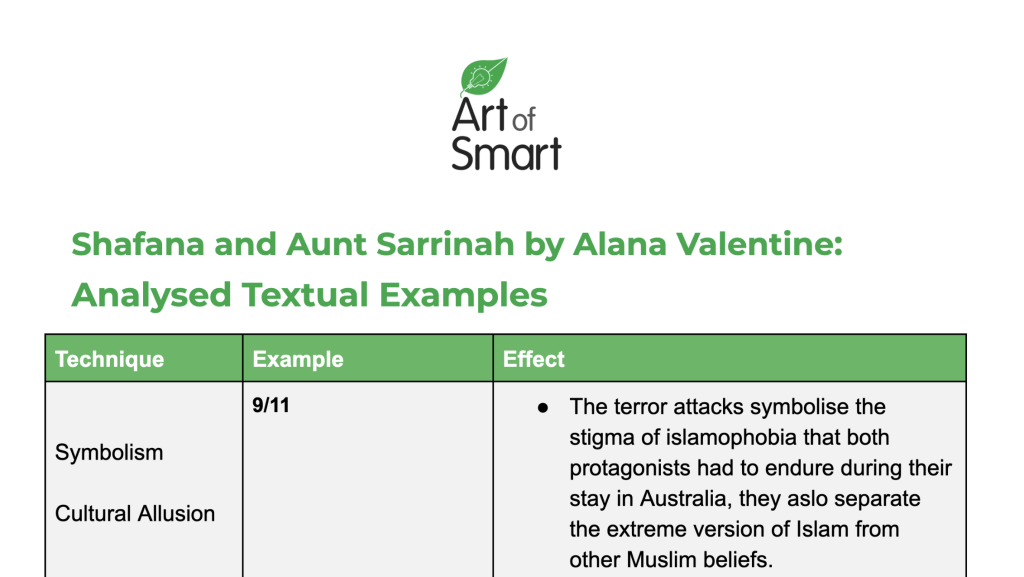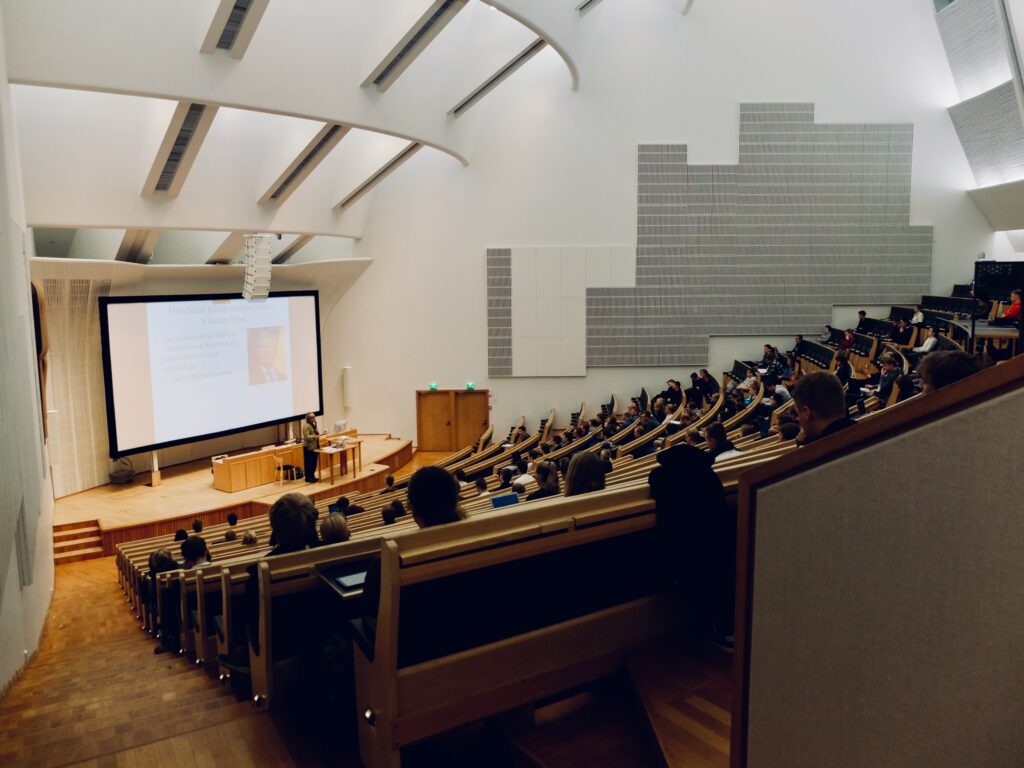Coming up with your analysis for ‘Shafana and Aunt Sarrinah’ by Alana Valentine?
You’ve come to the right place! Here is a summary of ‘Shafana and Aunt Sarrinah’, along with its key themes and a step-by-step guide on how to break down and ace your text analysis.
We also threw in a FREE sample analysis table (also known as a TEE table) and a sample paragraph for you!
So, let’s go and vamp up your essay!
Summary of Shafana and Aunt Sarrinah by Alana Valentine
Key Characters
Context
Themes Explored in Shafana and Aunt Sarrinah
Analysis of Shafana and Aunt Sarrinah by Alana Valentine
Summary of Shafana and Aunt Sarrinah by Alana Valentine
Content warning: racism, violence
This insightful play opens when Shafana, a brilliant Afghan university PhD student in Australia, is rehearsing a presentation about deep sea shrimp and the constant threats these have to endure in their life cycle.
Enter her aunt Sarrinah, an Afghan PhD graduate who left Afghanistan to get another PhD and find work in Australia.
Sarrinah starts teasing Shafana about her delivery and wording, and reminds her that she has to renew her university ID, just as she does, suggesting they renew their university IDs.
Despite this being considered a great accomplishment for the both of them, Shafana says no and says she will give her Aunt the reason over dinner.
Flashback to her childhood during her first years in Australia with her refugee family, Shafanah remembers being embarrassed by her Aunt’s broken English during those first years and remembers questioning Sarrinah about her starting job at a factory.
Believing her Aunt was better than everybody else, she is reprimanded by Sarrinah for thinking so.
Back to the present, Sarrinah questions Shafana about her newly-bought hijab, thinking she might get harassed by racists and saying it is dangerous.
Shafana dismisses these worries. She explains her ideas about a ‘soft islamic revolution’, that advocates for human right through the Qu’ran.
Seeing Shafana caught up in her islamic identity, Sarrinah worries she might turn to extremism, as Sarrinah is less concerned with religion and more with science.
Sarrinah recounts a traumatic incident where she refused to wear a full body chador due to the heat. She was kicked and beaten off the bus along with her family by Taliban guards as they were trying to escape Afghanistan.
As Shafana leaves, we have a flashback of Sarrinah and her niece watching the news on 9/11. At the same time, Sarrinah decides to study for an Australian PhD, to find a better job and avoid Islamophobia at work.
Sarrinah visits Shafana one last time to see if she has changed her mind about going for their IDs together. She hasn’t.
Instead, Sarrinah surprises her putting on the hijab, and realises the closeness between the two of them is slipping away, due to their different approaches to Islam.
Sarrinah jokes that they are now opponents, but still niece and aunt, and leaves kissing her on the forehead.
The play ends with Shafana practising her speech to the audience once again.
Key Characters
Shafana
Shafana is a young and brilliant PHD student who left Afghanistan as a 14 year old with her family, due to the Afghan civil war in 1989.
The play’s tension is incited with Shafana’s decision to wear a hijab, that her Aunt disapproves of and that sees them drift apart.
This has shaped her life significantly, as she was granted entry to Australia much earlier than her family members, left behind in India for some time.
During this time of separation, Shafana grew close to Sarrinah, who has acted as a mother to her.
As Shafana learned about the Australian way of life, she felt uneasy with her Aunt’s struggle to embrace Australian culture as easily as she did.
Shafana also felt that her Aunt was overqualified and much more deserving than the jobs they gave her at a local factory.
Fast forward to the present day, Shafana embraces her Islamic identity and regrets assimilating so quickly to Australian culture.
This change of mind was spurred on the rampant Islamophobia after 9/11, which moved her to reorient her understanding of Islam away from the reactionary narratives in Western media.
Sarrinah
Sarrinah has a similar background to Shafana.
Upon leaving Kabul, she had no way to use her professional qualifications in Australia.
Despite being a well regarded engineer in her home country, she had to settle for less prestigious jobs when she first moved.
When Shafana talks to her about her hijab, she is disappointed, as she has always regarded science above religion, and is displeased with anyone putting so much time into their religious identity.
After struggling to learn the accent and pick up the “Australian” way of life, she eventually reaches the same position she was in in Afghanistan in terms of her career.
After 9/11, however, she resigned her position due to islamophobia in her workplace.
Instead, she gets her PhD that she initially could use in Afghanistan, but in Australia. She is able to teach at a university.
Context
Civil War in Afghanistan
The play takes place in two different historical contexts.
The first occurs in Shafana’s childhood and Sarrinah’s traumas during their escape from the Afghanistan’s civil war.
This was a time where Afghanistan was cleaved apart and the Taliban tried to impose their interpretation of Muslim law on the people of Afghanistan. This interpretation can be considered as very repressive, especially with respects to women’s rights.
According to Taliban rule, women were not permitted to hold jobs or have significant education. This meant Sarinnah’s right to her job and PHD was taken away.
Hence, we can deduce Sarrinah’s dislike for those who are extremely devout or consider it an important part of their identity.
Notice that she maintains their family is Persian, a ‘race’ of peoples that encompasses many nations, such as Afghanistan and Iran, as well as many faiths, not just Islam.
This is contrary to Shafana, who keeps using Arabic words and expressions, maintaining thus she has Arabic heritage, and therefore is inextricably tied to islam.
9/11 and the Aftereffects
Following 9/11, islamophobia spread quickly among Western countries.
This affected Shafanah and Sarrinah in different ways, creating an intriguing and conflicting dynamic between them.
It pushed Sarrinah further away from Islam, as she quit her job due to islamophobia and spent her time to getting PHD in English.
Conversely, it pushed Shafana closer to Islam as she was motivated to revisit that part of her identity.
Themes Explored in Shafana and Aunt Sarrinah
Religious Identity
This is the main source of conflict in the play.
Despite Shafara and Sarinnah shared similar experiences back in Afghanistan and islamophobia in Australia, the generational gap shows how religion affects both protagonists differently, and separates their otherwise close bond.
Sarinnah distances herself from religion, given her traumatic experiences under the Taliban and the discrimination she suffered during 9/11.
Shafara is drawn closer to Islam and makes it the focal point of her identity, pushing thus Sarinnah away.
This dynamic is essential to understand because it turns out that the religious differences between aunt and niece overpowers their bond as a family, as the play ends confrontationally.
Migration and Identity
This point applies more to Shafana.
After fleeing her own country and living in another, Shafana is forced to adopt a completely new and diferent way of life, as well as values and customs. She loses touch with her religion and origins.
After 9/11, she re-examines the values of her religion and makes her beliefs the centre of her being.
We see a nuanced perspective of her life, as she changes from being embarrassed about Islam (to the point of resenting her Aunt for not adapting to a western way of life) growing up to embracing her cultural background.
How to Analyse Shafana and Aunt Sarriah in 3 Steps
Step 1: Choose your example
The best way to choose an example is to choose a technique.
Remember you must include stylistic devices (how images and words are arranged in a text in order to produce meaning), and aesthetic features (elements that prompt a critical response from the reader) in your essays to gain the most marks.
In this case, we will use the quote:
“Hijab is an Arabic word. Meaning partition. We are not Arabs. We are Persians.”
Step 2: Identify your technique(s)
The play is all about the chasm that divides Shafana and Sarinnah.
This subtle, yet revealing, quote uses both allusion and symbolism.
You should make use of both these techniques to make sure you understand the nuances of the quote, as well as reading up about the differences between the Arabic and Persian world.
Step 3: Write the analysis
Always be ready to ask yourself what the author intended you to feel/respond emotionally by reading the example quote.
This will make sure that you tackle an important part of the analysis for Shafana and Aunt Sarinnah, which is the effect on the reader.
Alana Valentine subtly yet masterfully conceals the growing tension between the two protagonists, Shafana and Sarrinah, by utilising both allusion and symbolism. When Sarrinah notices Shafana uses the Arabic word for hijab, she immediately picks up on the connotations this implies: “Hijab is an Arabic word. Meaning partition. We are not Arabs. We are Persians.” In turn, audiences understand for the first time the different paths that both women are taking, that are bound to separate. This in turn creates dramatic tension, and is what pushes their relationship towards a strain during the final scenes of the play.
Need some help analysing other texts?
Check out other texts we’ve created guides for below:
- ‘Red’ by Ted Hughes
- Like a House on Fire
- Good Night and Good Luck
- Amélie
- King Lear
- One Flew Over the Cuckoo’s Nest
- Fever 103
- I Felt a Funeral in a Brain
- Journey of the Magi
- Rhapsody on a Windy Night
- Frank Hurley: The Man Who Made History
- Mabo
Are you looking for some extra help with your analysis of Shafana and Aunt Sarrinah by Alana Valentine?
We have an incredible team of English tutors and mentors!
We can help you master your analysis of Shafana and Aunt Sarrinah by taking you through the summary, context and themes. We’ll also help you ace your upcoming English assessments with personalised lessons conducted one-on-one in your home or online!
We’ve supported over 8,000 students over the last 11 years, and on average our students score mark improvements of over 20%!
Give us a ring on 1300 267 888, email us at [email protected] or check us out on TikTok!
Vittorio Manessi is an Art of Smart tutor based in Queensland studying environmental science. He was one of the first Year 12 students to study under the new ATAR system in Queensland. He enjoys Maths, Science, English and Ancient History and is keen to share his knowledge of the QCE by making awesome resources.







